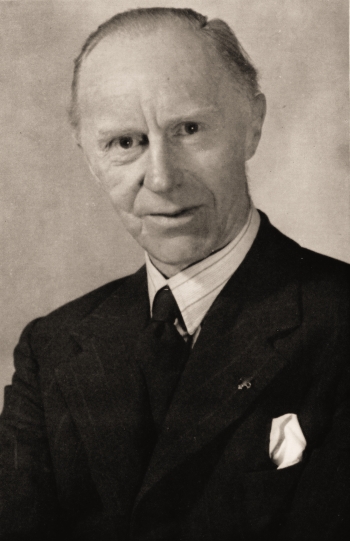In Memoriam
Since the publication of the last Journal the following members have died: Davis Burrow, W. Wells-Hood, W. H. Watson.
Davis Burrow
By the death of Davis Burrow in November 1964 one more link was severed in the chain connecting potholers of today with the Golden Age of cave exploration in the early years of the century. Davis was only fifteen when, in 1905, he was introduced to potholing by Mr. F. Haworth, a master at Leeds Modern School and Mr. E. Simpson. In that year, with his cousin Charles Burrow, he was a member of the first party to force a way into Mere Gill, when the top of the second underground pitch was reached, a remarkable performance, bearing in mind the extreme youth of some of the party and the heavy 12 in. ladders then in use. Their appetite whetted, the little group decided to form a club and so the Yorkshire Speleological Association was born, probably the first purely caving club started in Britain, which flourished until its members were scattered during the first World War.
The attack on Mere Gill was renewed in 1906, but continuous bad weather prevented further progress and the efforts of the party, including Davis, were switched to the newly discovered Hardraw Kin, which was descended for the first time. The years 1907 and 1908 were both very active; Davis took part in one of the earliest explorations of the now notorious Dow Cave, Kettlewell, penetrating 500 yards. Rowten Pot, Rift Pot and Jingling Pot, Kingsdale, were bottomed for the second time. Much exploration took place in Gaping Gill where new discoveries included the 90 ft. pot under the West Slope and a circular route beginning at the west end of the Main Chamber, going by way of the West and Pool Chambers to the east end of the Main Chamber. Another major success was the discovery of the through route from Long Kin East into Rift Pot. But without doubt the greatest feat of the two cousins was the finding and forcing of the Flood Exit route into Gaping Gill in 1909, perhaps the first successful potholing “dig” in Great Britain. That its discovery was not the result of a lucky chance but of scientific observation and deduction throws an interesting sidelight on the mature and competent approach of the young cousins.
In the 1914 to 1918 war Davis served in the R.F.C. (now R.A.F.) and later was transferred to the Argyll and Sutherland Highlanders. He narrowly escaped death when hit on one occasion by four machine gun bullets and he finished the war with a duodenal ulcer as a well as a bullet-scarred body.
Davis and his cousin joined the Y.R.C. in 1919, where Davis’ wonderful spirit enabled him to take up again his pre-war interest in potholing and climbing. Although his physical strength was diminished his fertile mind, his competence as a craftsman in wood and as an engineer and above all his ability to make friends and impart his enthusiasm to others, made him a tower of strength in the Club. In those days immediately following the ladder era, the usual entry into Gaping Gill was by bosun’s chair lowered from the end of the Jib Tunnel by a painfully laborious wooden hand winch. The two cousins very soon engineered a new line of descent by the main shaft using a steel winch powered by a petrol engine. Davis/ gave considerable thought to the design of ladder rungs with the object of combining lightness with strength and he constructed the first rope ladders used by an Everest expedition. He had a great capacity for fun and good humour and, with Arthur Horne, originated the series of ‘stunts’ which helped to make the Hill Inn Meet so immensely popular.
Davis served on the Y.R.C. Committee from 1922 to 1924 and from 1925 to 1928. In 1929 he became Honorary Secretary and continued as such until 1946, the last few years jointly with F. S. Booth. He was a Vice-President from 1946 to 1948, became a Life Member in 1950 and was elected President from 1950 to 1952. The Club honoured him by making him an Honorary Member in 1959.
In 1917 he married Miss Winifred Yates and, because of her great practical interest in Girl Guides he also helped. This led him towards the Scout Movement in which for twenty-one years up to 1956 he played an important part in Central Yorkshire. For many years his main interest was with Rover Scouts, young men over eighteen and he introduced many of them to the caves, crags and hills he loved so well. In 1949 he was appointed County Commissioner, responsible to Chief Scout for the welfare, progress and training of some ten thousand boys and over a thousand adult leaders. On his retirement he was awarded the “Silver Wolf”, Scouting’s highest award, “for services of the most exceptional character”.
Davis was head of the family business and served for many years on the National Committee of the Brush Manufacturers’ Association and as its President during 1948/50, two of the difficult years immediately after the second World War.
Ill health prevented him attending many Club Meets in his last few years but in his earlier days he was a strong rock climber and few were his equal in underground techniques. Clearly he was a leader of men, but the quality that many of the older members will never forget was his great friendliness and his ability to make the newly joined member feel at ease and one of the Club on his first Meet.
In Davis Burrow the Club has lost one of its stalwarts and to many of those who knew him well, a very good friend.
H.L.S.
F.S.B.
